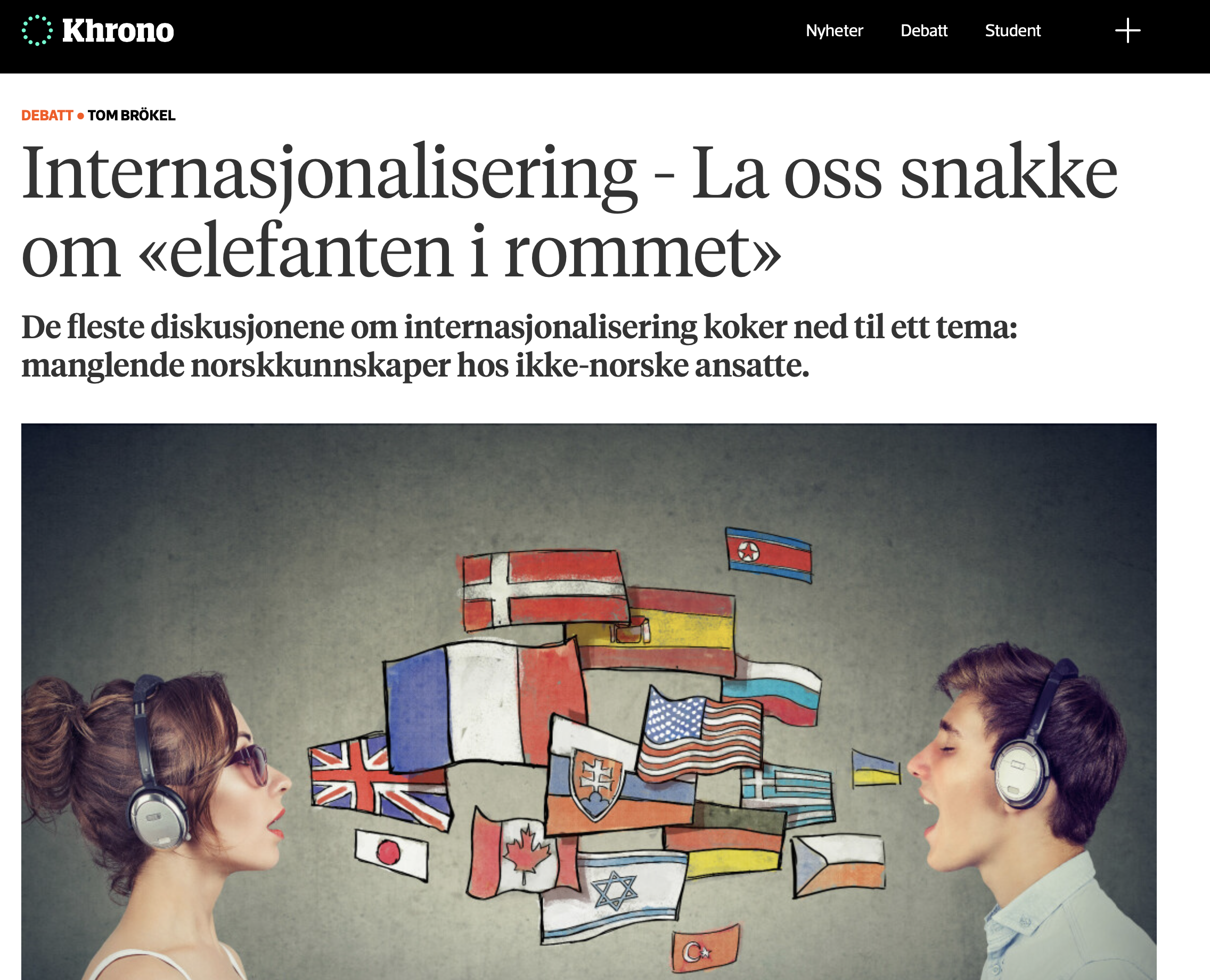
Recently, discussions concerning the internationalization of the Norwegian academic system peaked again. We’ve heard a lot about how much internationalization of the academic system is appreciated and how universities seek to improve the process. And the issue is a pressing one: at the University of Stavanger, roughly 30% of its employees have a non-Norwegian background and this share is quickly increasing.
However, most discussions on this topic (e.g., too little representation of internationals in higher-level university governmental bodies, Bachelor teaching, public debates) eventually boil down to one topic: internationals’ lack of Norwegian language skills.
On paper, the solution to this is already in place: new hires are required to learn Norwegian up to a B2 level within two to three years. This level is argued to imply a “good” command of the Norwegian language, which is frequently equated to an expectation of frictionless communications in Norwegian. I will refrain from discussing if this “solution” works and if it is delivering what its advocates promise (spoiler: it does not). One can also discuss endlessly the pros and cons of keeping Norwegian as the “working language” at universities. In the end, it is a purely political decision if one deems the resources for internationals learning Norwegian well-spent or not. However, the real elephant in the room is the question of who is bearing these costs in reality. Currently, it is the Norwegian society that expects internationals to learn Norwegian, by including this as a requirement in their work contracts. I think it is safe to assume that only a minority of internationals learn Norwegian because it gives them pleasure. At this point, I would kindly like to remind the Norwegian reader to reflect back on how much fun they had learning German in high school. Imagine doing the same today. At the age of 40+. With all teaching and materials in English. For three hours after a full workday. Twice per week. Every week. Elsker du ikke å lære Tysk?
So, let’s look at this from the perspective of internationals. In a fair and open competition, they have been selected as the best fitting experts to do a specific job, potentially over other researchers fluent in Norwegian. More importantly, they are offered the (almost) same work contracts and operate under the same framework as individuals fluent in Norwegian. For instance, at my institution (University of Stavanger Business School), 40% of their 37.5 working hours are to be spent on research, 40% on teaching, 10% on administrative duties, and 10% on supervision. Usually, internationals are not treated any differently than their Norwegian colleagues from day one onward. They teach the same number of hours, apply for grants, write journal articles, supervise PhD students, etc. In fact, according to Nifu (https://khrono.no/files/2021/11/26/tidsbrukunderøkelse_nifu_2021.pdf), they even tend to do this a bit more extensively than their Norwegian counterparts.
However, there is still this elephant! In contrast to their colleagues, they are also required to learn Norwegian at B2 level within 3 years. In practice, this implies completing four Norwegian courses: A1, A2, B1, and B2. An A1 course implies 85 hours of in-class learning, and at least the same number of hours are needed in addition to preparation and homework. In sum, 170 hours per course. In total, 680 hours. For individuals with no background in Germanic languages, this can be considered an absolute lower bound.
As pointed out above, reaching the B2 level is part of internationals’ work contracts. However – and here is the elephant’s face – the hours they need to invest are subtracted from their private/family time! Over a course of three years, this requirement translates into roughly 6-7 additional working hours per regular working week. In practice, this means that individuals who are busy figuring out how to build up their life in a new country, who have homework, families, hobbies like any Norwegian, are implicitly demanded to put in an extra day of work every week. For those with families, this is extra hard, as internationals by default tend to have little to no access to the support of relatives living close by.
Unfortunately, there is more. B2 is by far an insufficient level to comfortably and confidently teach or supervise in Norwegian. Given the richness of dialects in the Norwegian language, B2 is generally insufficient to even fully follow the conversation between native speakers, let alone participate as an equal in conversations held in Norwegian. In most cases, it does not even open new communication possibilities, as most Norwegians (thankfully) are fluent in English. Hence, internationals must add a third or fourth language to their portfolio, and, in doing so, must sacrifice their private life or research time (reducing work hours implies less research time because they can’t unilaterally reduce their teaching load), only to be able to talk to the same persons with whom they can already communicate in a much more efficient manner. Hence, to get there, significantly more training and resources are necessary. It is really difficult not to consider opportunity costs here. People have been brought to Norway because of their crucial skills and knowledge. However, they are actively prevented from fully utilising these skills because they must spend time and resources (don’t underestimate the cognitive drain of learning a new language) to learn Norwegian.
In any case, it becomes clear that the requirement to learn Norwegian without it being accounted for as working hours is either gross exploitation of the relatively weak bargaining position of internationals, or unawareness of its true costs, which currently are hidden in the private lives of internationals.
I leave it to the reader to assess if investing all these hours by experts with crucial skills in something that brings, in most cases, limited value, is worthwhile. In the end, it is, as stated above, a political decision. However, I fail to see that it should be the internationals and their families that bear the costs of this desire. If the Norwegian society believes that learning Norwegian is a worthwhile investment, it is only fair that it also carries the costs. That implies treating learning Norwegian as any other training offered to employees – by accounting for it in working hours. Thereby, internationals will actually be enabled (and not only required) to engage with it.
